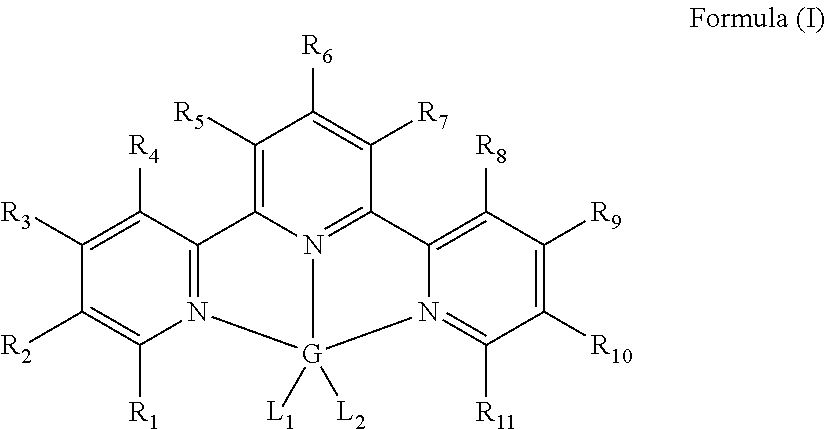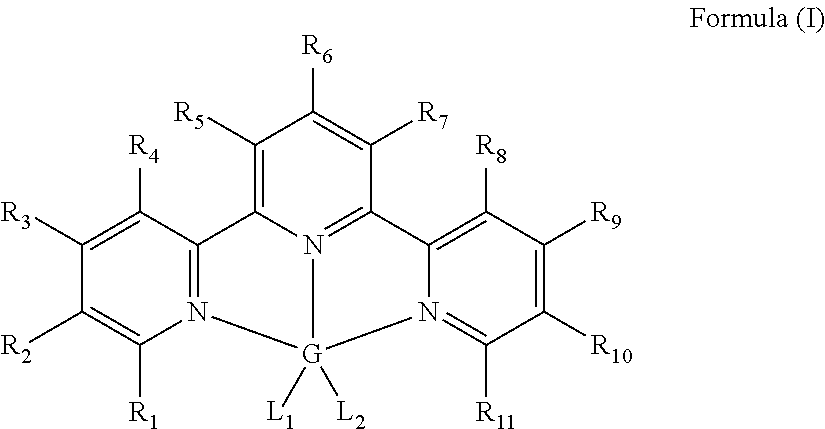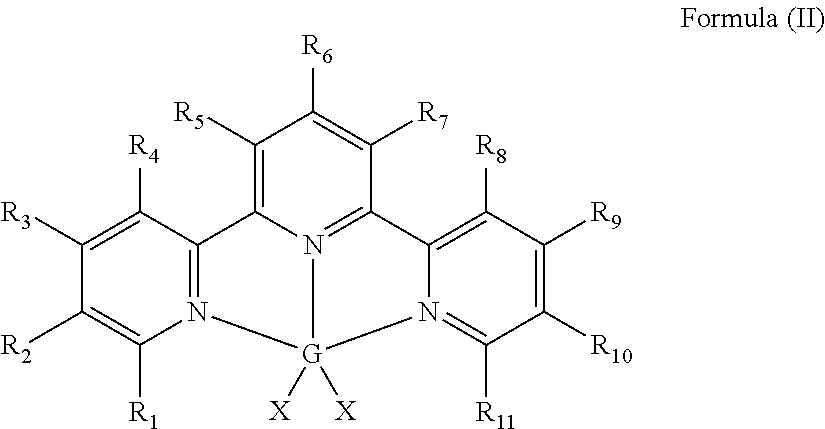Hydrosilylation Catalysts
a catalyst and hydrosilylation technology, applied in the direction of organic compound/hydride/coordination complex catalyst, physical/chemical process catalyst, iron organic compound, etc., can solve the problem of reducing the performance of precious metal complex catalyst in end-use applications, forming undesirably odoriferous by-product compounds, and inefficient catalytic performance of precious metal complex catalys
- Summary
- Abstract
- Description
- Claims
- Application Information
AI Technical Summary
Problems solved by technology
Method used
Image
Examples
example 1
Preparation of Iron (II) Terpyridine Dichloride
[0057]In an inert atmosphere, a scintillation vial was charged with 0.233 g (1.0 mmol) of terpyridine and 0.126 g (1.0 mmol) of ferrous dichloride. Approximately 20 mL of dry THF was added to the mixture and the resulting slurry was stirred overnight. Then approximately 50 mL of pentane was added resulting in precipitation of a purple solid. The solid was collected and dried in vacuo to yield 0.345 g (96%) of the iron (II) terpyridine dichloride. The sample was compared to previously reported compound. See Reiff, William M.; Erickson, N. E.; Baker, Willie Arthur, Jr. Mono(2,2′,2″-terpyridine) complexes of iron(II). Inorganic Chemistry (1969), 8(9), 2019-21.
example 2
Preparation of Bis[(trimethylsilyl)methyl]iron(II)terpyridine
[0058]In an inert atmosphere, a round bottomed flask was charged with 0.360 g (1.0 mmol) of terpyridine iron dichloride, and approximately 10 mL of diethyl ether. The flask was chilled to −35° C. A solution containing 0.188 g (2.0 mmol) of LiCH2SiMe3 was added followed by approximately 10 mL of diethyl ether. A color change occurred immediately upon addition and the resulting slurry was stirred and allowed to warm to ambient temperature. After stirring for one hour, the reaction mixture was filtered through Celite® and the volatiles were removed in vacuo. The resulting paramagnetic purple solid was washed with approximately 5 mL of cold pentane yielding 0.400 g (87%) of the title compound. 1H NMR (benzene-d6, 20° C.): δ=319.80 (bs, 1H), 194.68 (bs, 2H), 154.65 (bs, 2H), 115.20 (bs, 2H), 59.36 (bs, 2H), 38.56 (bs, 2H), 8.73 (bs, 18H).
example 3
Hydrosilylation of 1-hexene with Et3SiH using Bis[(trimethylsilyl)methyl]iron(II)terpyridine catalyst
[0059]A stock solution containing 5 mg of bis[(trimethylsilyl)methyl]iron(II) terpyridine and 0.60 g of toluene was charged into a scintillation vial in a nitrogen filled drybox. The toluene was removed in vacuo followed by addition of 0.114 g (1.4 mmol) of 1-hexene. To the same vial, 0.105 g (0.90 mmol) of Et3SiH was added. The vial was sealed with a small amount Krytox grease and electrical tape, removed from the drybox and placed in a 95° C. oil bath. The concentration of the iron complex was less than 0.1 mol % relative to the silane, and the reaction time was 4 hours to achieve greater than 90% conversion to (CH3CH2)3Si—(CH2)5—CH3. Less than 5% each of (CH3CH2)3Si—CH═CH—(CH2)3—CH3 and (CH3CH2)2(H)Si—(CH2)5—CH3 were formed.
[0060]To perform the reaction in a solvent such as toluene, the above procedure was carried out without removal of the solvent from the stock solution. The con...
PUM
| Property | Measurement | Unit |
|---|---|---|
| valences | aaaaa | aaaaa |
| temperatures | aaaaa | aaaaa |
| valence states | aaaaa | aaaaa |
Abstract
Description
Claims
Application Information
 Login to View More
Login to View More - R&D
- Intellectual Property
- Life Sciences
- Materials
- Tech Scout
- Unparalleled Data Quality
- Higher Quality Content
- 60% Fewer Hallucinations
Browse by: Latest US Patents, China's latest patents, Technical Efficacy Thesaurus, Application Domain, Technology Topic, Popular Technical Reports.
© 2025 PatSnap. All rights reserved.Legal|Privacy policy|Modern Slavery Act Transparency Statement|Sitemap|About US| Contact US: help@patsnap.com



